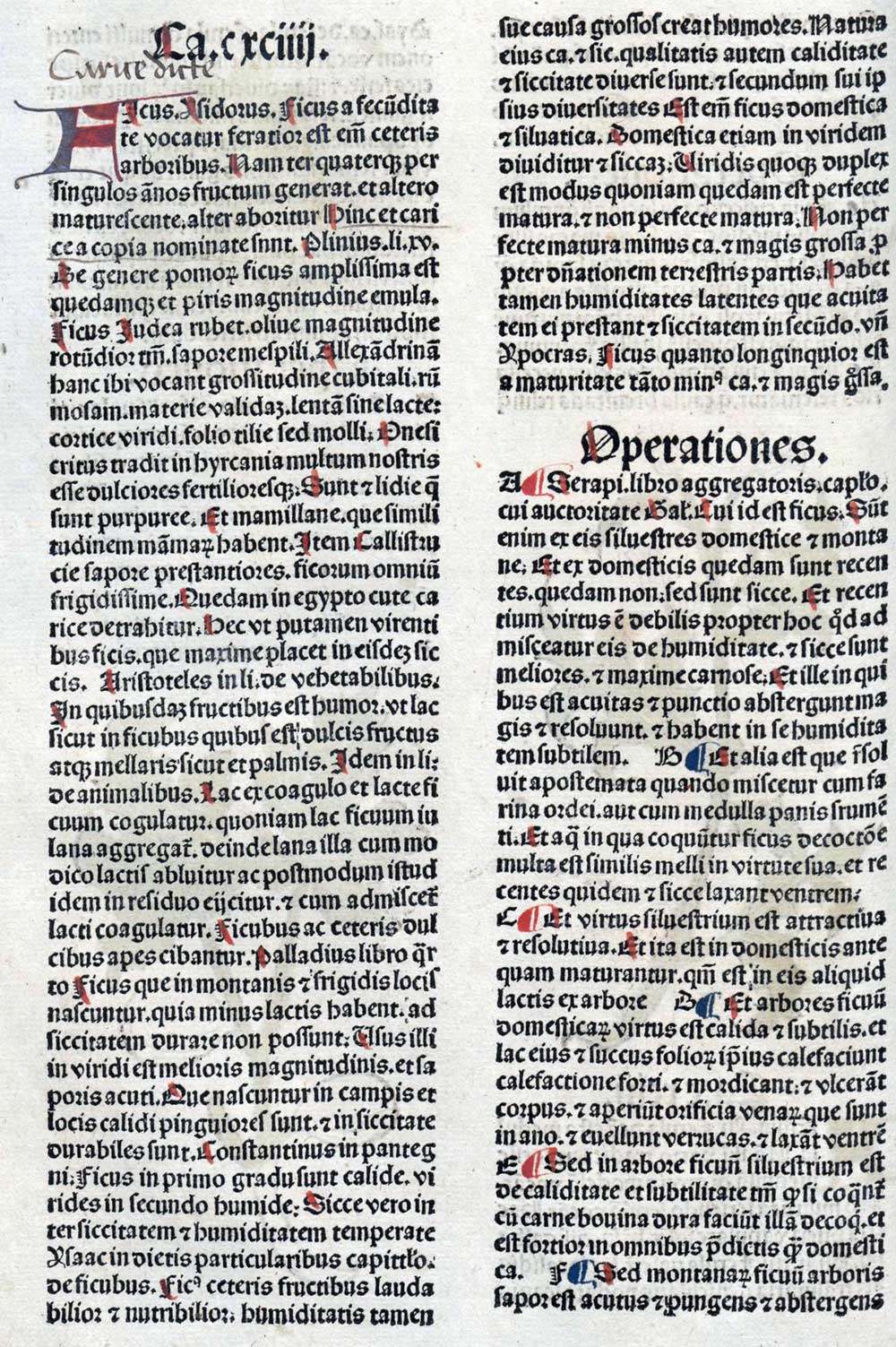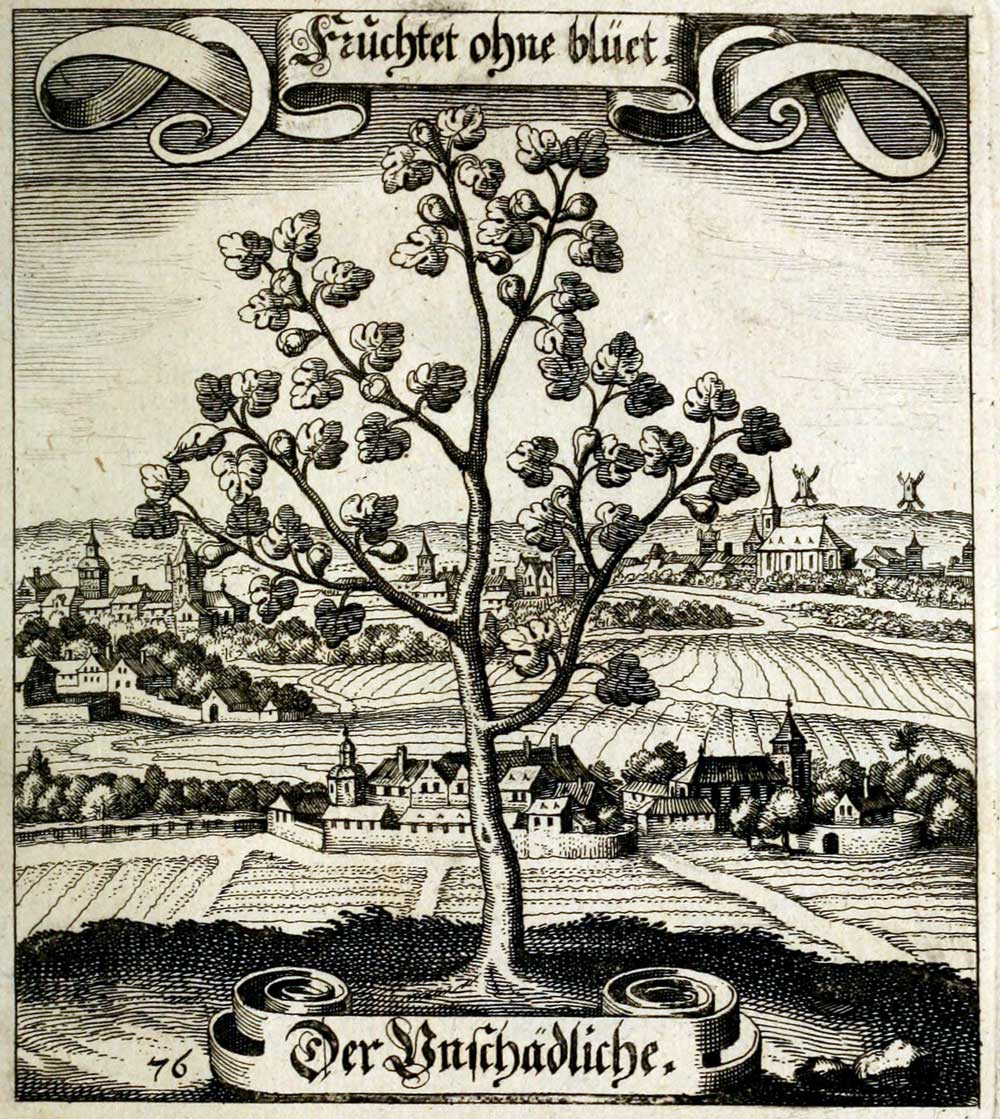the smell of the fig, to mad bulls;
Original French: le flair du Figuier, aux Taureaux indignez:
Modern French: le flair du Figuier, aux Taureaux indignez:
Among the examples of pairings whose antipathies are not as vehement as the hatred thieves have of a certain usage of Pantagruelion.
Notes
Ficus (text)
Ficus carica
le flair du Figuier, aux Taureaux indignez
caprificus tauros quamlibet feroces collo eorum circumdata in tantum mirabili natura conpescit ut inmobiles praestet.
The wild fig, if a branch be put round the neck of a bull, however fierce, by its miraculous nature so subdues the animal as to make him incapable of movement.
The Smell of the Fig-tree to mad Bulls
Table-Talk II, Question 7
1. Once, when small fish of all sorts were served to us, Chaeremonianus of Tralles pointed out one with a sharp, elongated head and said that the echeneïs resembled it; he had seen (he said) the echeneis while sailing off Sicily and had been amazed at its power, for during the course of the voyage it had been responsible for no little loss of speed and delay until the look-out had caught it sticking to the outer face of the vessel’s hull. At this, some laughed at Chaeremonianus for accepting a mythical and unbelievable fabrication; others chatted about the “antipathies” [1]; and one could hear much else and also the following about things antipathetic: the sight of a ram stops a mad elephant; if you point an oak twig at a viper and touch it, the viper is brought to a standstill; a wild bull is quieted and made gentle if bound to a fig-tree [2]; amber moves and attracts all light things, except basil and whatever is wet with oil; the loadstone does not attract iron rubbed with garlic. Indeed these things are subject to a clear test, but it is hard (they said) to determine the cause, if not altogether impossible.
1. Bolus of Mendes, the former of Democritus exposed by Callimachus, wrote a Sympathies and Antipathies (in nature); see Diels, Frag. d. Vorsokratiker, Demokritos 300. 1–5; cf. infra, iv. 2, 664 c.
2. Cf. infra, 696 f, where the theory is different.
the fiercest of bulls, if tied to a fig tree, becomes quiet
Table-Talk IV., Question 10
Two things indicate that a strong, intense exhalation [1] is given off by the fig tree; first, our sense of smell, and second, the alleged fact that the fiercest of bulls, if tied to a fig tree, becomes quiet, lets people touch him, and completely abandons his rage, as if the spirit were withering within him. This effect is mainly due to the bitterness of the plant, for the fig is the richest in sap of all plants, not only the fruit but the wood and the leaf too being full of it.
1. G. Soury connects this with Stoic theory (pneuma is the word used) in Revue Ét. Gr. lxi (1949), pp. 322 f. Cf. supra, 642 c.
The Smell of the Fig-tree to mad Bulls
Pliny xxiii. 7 § 64.
le flair du Figuier, aux Taureaux indignez
D’après Pline, XXIII, 64, «Caprificus tauros quamlibet feroces, collo eorum circumdata, in tantum mirabili natura compescit ut immobiles præstet.» Cette légende se retrouve dans Plutarque (Quœst. Sympos., 7) et Isidore de Séville (Orig., XVII, 7). Il s’agit ici du figuier sauvage, Ficus carica. L. (Paul Delaunay)
Nenuphar…
Encore une fois, la plupart de ces exemples se retrouvent dans le De latinis nominibus de Charles Estienne. Le nenufar et la semence de saule sont des antiaphrodisiaques. La ferula servait, dans l’Antiquité, à fustiger les écoliers (cf. Martial, X, 62-10).
le flair du Figuier, aux Taureaux indignez
Un collier de figuier immobilise les taureaux (Pline, XXIII, lxiv).
fig
fig. Forms: fige, fyg(g(e, , figg(e [adopted from Old French fige, figue, adaptation of Provençal figa, figua: -popular Latin *fica fig, formed on Latin ficus fig-tree, fig.]
The fruit of the fig-tree or Ficus, esp. the fruit of the Ficus carica.
A. 1225 Ancren riwle R. 150 Swete frut, þet me clepeð figes.
C. 1325 Richard Coer de Lion 1549 Fyggys, raysyns, in frayel.
1393 William Langland The vision of William concerning Piers Plowman C. iii. 29 Ne on croked kene þorne kynde fygys wexe.
C. 1400 Maundev. (1839) v. 50 Fyge trees þat beren no leves but fyges vpon the smale braunches, & men clepen hem Figes of Pharoon.
C. 1430 Two Cookery-bks. 15 An sethe fygys in Wyne & grynde hem.
1591 Joshuah Sylvester, translator Du Bartas his divine weekes and workes i. iii. 573 The milky Fig, the Damson black and white.
1671 William Salmon Synopsis medicinæ iii. lxxxii. 713 Apply a Cataplasm of Figgs and Raisons stoned.
fig-tree. Any tree of the genus Ficus, especially Ficus carica.
1382 John Wyclif Bible Numbers xx. 5 The whiche ne fige getith, ne vynes, ne powmgarnettis.
C. 1400 Romance of the Rose 1364 Fyges, & many a date tree There wexen.
C. 1440 Promptorium parvulorium sive cleriucorum 159 Fygge or fyge tre, ficus.
1763 Churchill Gotham 1, The Fig, which gave our first Parents Cloaths.
A poisoned fig used as a secret way of destroying an obnoxious person. Often fig of Spain, Spanish, Italian fig. Obsolete
C. 1589 Theses Martinianæ 21 Have you given him an Italian figge?
1616 R. C. Times’ Whistle iii. 1151 This boy… long he shall not soe, if figs of Spain..their force retaine.
16.. North Theret’s Lives (1657) 45 Tamberlaine… did cause a Fig to be given him, and after his death married his widow.
1670 G. H. Hist. Cardinals iii. i. 233 Some report he was poyson’d with an Italian Fig.
1691 Bethel Provid. God 33 He… durst not have disobeyed for fear of a Dose, or a Fig.

